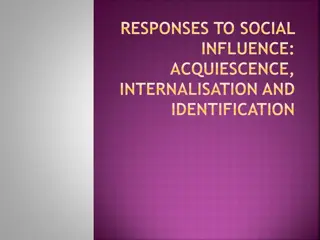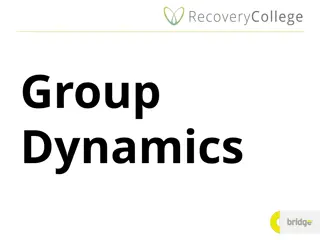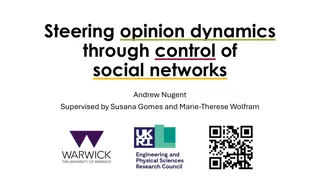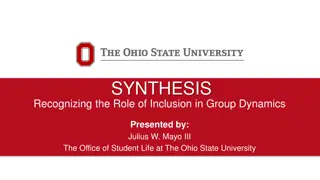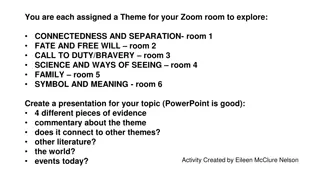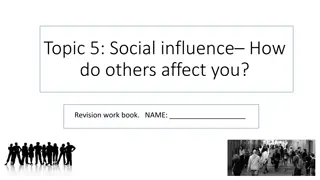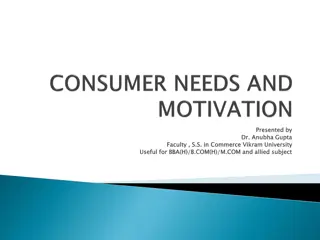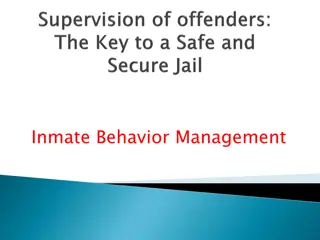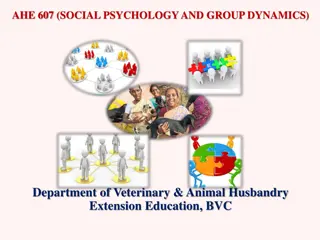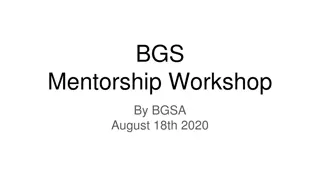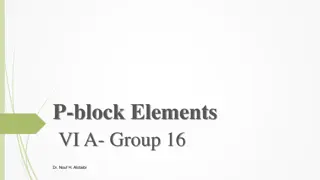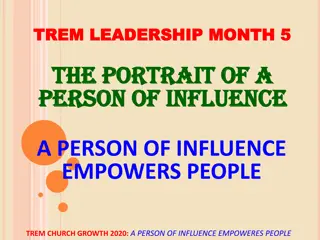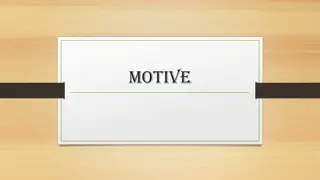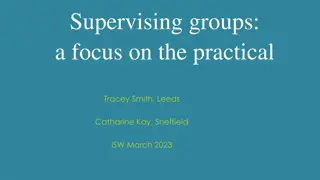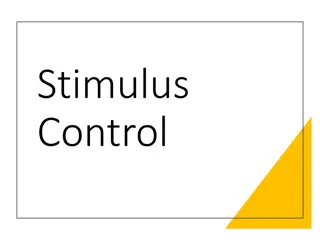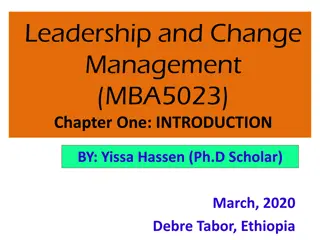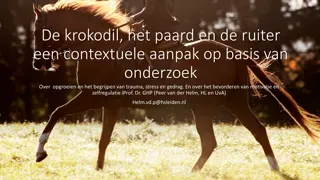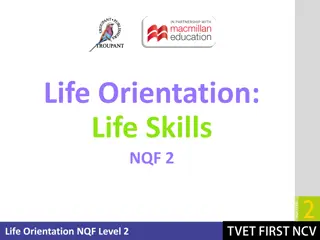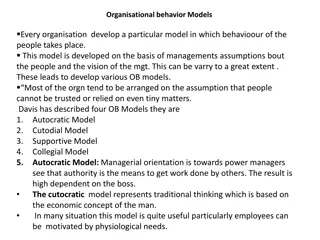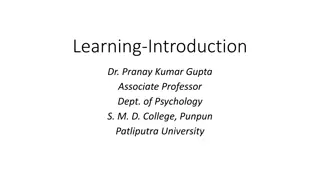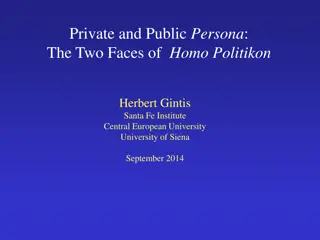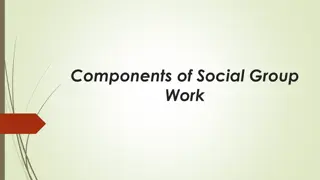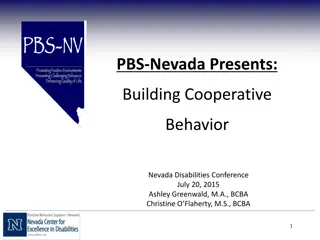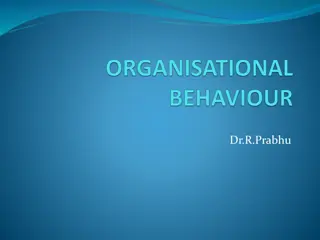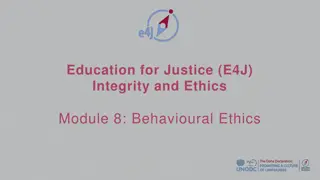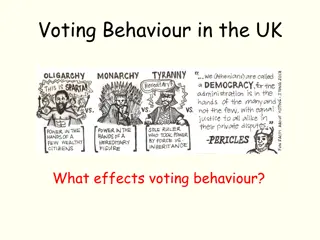Understanding Group Behavior: Influence and Dynamics
Explore the impact of social facilitation, social loafing, and deindividuation in shaping individual actions within groups. Understand how group interaction can lead to phenomena like group polarization and groupthink. Dive into the role of the Internet in exacerbating group polarization and how culture influences our behaviors. Discover real-life examples and implications of these concepts in various contexts.
Download Presentation

Please find below an Image/Link to download the presentation.
The content on the website is provided AS IS for your information and personal use only. It may not be sold, licensed, or shared on other websites without obtaining consent from the author. Download presentation by click this link. If you encounter any issues during the download, it is possible that the publisher has removed the file from their server.
E N D
Presentation Transcript
Learning Targets 76-1 Describe how the presence of others influences our actions via social facilitation, social loafing, and deindividuation. 76-2 Explain how group interaction can enable group polarization. 76-3 Discuss the role the Internet plays in group polarization. 76-4 Discuss how group interaction can enable groupthink. 76-5 Describe how culture affects our behavior. Module 76 Group Behavior
What is social facilitation? improved performance on simple or well-earned tasks in the presence of others
How does social facilitation impact performance? Skilled athletes often find they are on before an audience. What they do well, they do even better when people are watching.
How does the presence of others amplify our reactions? The presence of others strengthens our most likely response the correct one on an easy task, an incorrect one on a difficult task. (Guerin, 1986; Zajonc, 1965) For example, expert pool players who made 71% of their shots when alone made 80% when four people came to watch them. (Michaels et al., 1982)
What if our skill or ability is lacking? The flip side to social facilitation is that if our likely response is poor that, too will be amplified. For example, poor shooters, who made 36% of their shots when alone, made only 25% when watched.
applying new concepts What examples can you provide of social facilitation? What have you seen happen on your team? With your friends? In your work? Share with the class.
What is the home team advantage? Home teams win about 6 in 10 games, with the home advantage being greatest for teamwork- centered sports, such as soccer and basketball. (Jones, 2015)
1. What Would You Answer? Maggie is an excellent hockey player, and she is playing in the final hockey game of her high school career. The cheering of the fans causes her to score three goals in the game, a record for her. The most likely explanation for her performance is A. social loafing. B. group behavior. C. social facilitation. D. deindividuation. E. group polarization.
What is social loafing? the tendency for people in a group to exert less effort when pooling their efforts toward attaining a common goal than when individually accountable Experiments in the United States, India, Thailand, Japan, China, and Taiwan have found social loafing on various tasks, though it was especially common among men in individualist cultures. (Karau & Williams, 1993)
Working hard or hardly working? In group projects, social loafing often occurs, as individuals free ride on the efforts of others.
What causes social loafing in a group? Members may feel less accountable and therefore worry less about what others think. Members may view their individual contributions as dispensable. (Harkins & Szymanski, 1989; Kerr & Bruun, 1983) Members may overestimate their own contributions, downplaying others actions. (Schroeder et al., 2016) Members may slack off if they share equally in the benefits, regardless of how much they contribute.
What is deindividuation? the loss of self-awareness and self-restraint occurring in group situations that foster arousal and anonymity The process of losing self-awareness and self-restraint, called deindividuation, often occurs when group participation makes people both aroused and anonymous.
What is an example of deindividuation? During England s 2011 riots and looting, rioters were disinhibited by social arousal and by the anonymity provided by darkness and their hoods and masks. Later, some of those arrested expressed bewilderment over their own behavior.
Does deindividuation always result in violence? Deindividuation can also result in prosocial actions. The releasing of self-restraint may allow an individual to dance like no one is watching, sing with the crowd or attempt to express themselves in a way they may not if not in the crowd. When we shed self-awareness and self-restraint whether in a mob, at a rock concert, at a ballgame, or at worship we become more responsive to the group experience bad or good.
Applying new information. How have you experienced social loafing, such as with group projects? What might be some ways to reduce social loafing on a team? Is it up to team members? The teacher or leader? Share your experience with the class.
What is group polarization? the enhancement of a group s prevailing inclinations through discussion within the group The beliefs and attitudes we bring to a group grow stronger as we discuss them with like-minded others. This process, called group polarization, can have beneficial results, as when low-prejudice students become even more accepting while discussing racial issues.
group polarization If a group is like-minded, discussion strengthens its prevailing opinions. Talking over racial issues increased prejudice in a high-prejudice group of high school students and decreased it in a low- prejudice group. (Data from Myers & Bishop, 1970.)
How does the internet increase group polarization? The Internet offers us a connected global world, yet also provides an easily accessible medium for group polarization. The Internet enables opinion bubbles: Progressives friend progressives and share links to sites that affirm their shared views. Conservatives connect with conservatives and likewise share conservative perspectives. With news feeds and retweets, we feed one another information and misinformation and click on content we agree with (Bakshy et al., 2015; Barber et al., 2015)
How is the Internet a social amplifier? Individuals visit websites that reflect their interests and concerns and are supported by others with the same views.
What are some pro-social and anti-social ways in which the Internet impacts ideas? Social media has been the moving force behind many political independence movements in countries such as Egypt with oppressive rulers because it allows like-minded citizens to band together. It has also fueled hate-driven, violent rallies that tear apart communities.
What is groupthink? the mode of thinking that occurs when the desire for harmony in a decision-making group overrides a realistic appraisal of alternatives Often when a group is involved in decision making, the hope that the group can arrive at a decision may subtly influence dissenters of the group decision to remain silent.
How does the 1961 Bay of Pigs fiasco illustrate groupthink? In 1961, U.S. President John F. Kennedy and his advisers decided to invade Cuba with 1400 CIA-trained Cuban exiles. When the invaders were easily captured and quickly linked to the U.S. government, Kennedy wondered aloud, How could I have been so stupid? Why did none of President John. F. Kennedy s advisers speak of the flaws in the invasion plan?
What conclusions were arrived at regarding groupthink? Social psychologist Irving Janis studied the decision- making process leading to the ill-fated invasion. He discovered that the soaring morale of the recently elected president and his advisers fostered undue confidence. To preserve the good feeling, group members suppressed or self-censored their dissenting views, especially after President Kennedy voiced his enthusiasm for the scheme. Since no one spoke strongly against the idea, everyone assumed the support was unanimous.
2. What Would You Answer? Marie disagrees with the idea her group is coming up with and initially tries to voice her concerns. After the initial try, Marie does not voice her own concerns and longer because she does not want to go against the group. Marie is being affected by A. group polarization. B. groupthink. C. social loafing. D. social facilitation. E. cultural influences.
What is culture? the enduring behaviors, ideas, attitudes, values, and traditions shared by a group of people and transmitted from one generation to the next Culture is what we eat at our dinner tables, the songs we learn as a child, the politics we support, the sense of independence or dependence we feel on family, the roles and norms we are raised with and the stories we pass on to our younger siblings, children and grandchildren.
What is your culture? What ideas, beliefs, behaviors and traditions make up your ethnic or religious culture? How about the culture of your school? What about American culture? Share with your classmates.
What is culture shock? When we don t understand what s expected or accepted, we may experience culture shock. When cultures collide, their differing norms often befuddle. Should we greet people by shaking hands, bowing, or kissing each cheek? Knowing what sorts of gestures and compliments are culturally appropriate, we can relax and enjoy one another without fear of embarrassment or insult.
How does culture vary over time? At the beginning of the last century, people lived in a world without cars, radio broadcasting, or widespread electric power and light. Since 1960, most Western cultures have changed with astonishing speed. Middle-class people enjoy the convenience of air- conditioned housing, online shopping, anywhere-anytime electronic communication, and enriched by doubled per- person real income eating out more than twice as often as did their grandparents back in the culture of 1960. Many people now enjoy expanded human rights.
Learning Target 76-1 Review Describe how the presence of others influences our actions via social facilitation and social loafing. In social facilitation, the mere presence of others arouses us, improving our performance on easy or well-learned tasks but decreasing it on difficult ones. In social loafing, participating in a group project makes us feel less responsible, and we may free ride on others efforts.
Learning Target 76-1 Review cont. Describe how the presence of others influences our actions via deindividuation. When the presence of others both arouses us and makes us feel anonymous, we may experience deindividuation loss of self-awareness and self- restraint.
Learning Target 76-2 Review Explain how group interaction can enable group polarization. In group polarization, group discussions with like- minded others strengthen members prevailing beliefs and attitudes.
Learning Target 76-3 Review Discuss the role the Internet plays in group polarization. Internet communication magnifies the effect of connecting like-minded people, for better and for worse. People find support, which strengthens their ideas, but also often isolation from those with different opinions. Separation plus conversation may thus lead to group polarization.
Learning Target 76-4 Review Discuss how group interaction can enable groupthink. Groupthink is driven by a desire for harmony within a decision-making group, overriding realistic appraisal of alternatives. Group leaders can harness the benefits of group interaction by assigning people to identify possible problems, and by welcoming various opinions and expert critique.
Learning Target 76-5 Review Describe how culture affects our behavior. A culture is a set of behaviors, ideas, attitudes, values, and traditions shared by a group and transmitted from one generation to the next. Cultures differ across time and space.


